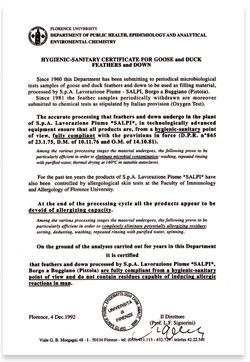SALPI's experience in the field of feathers and down is supplemented by SALPI's know-how in the use of special pure cotton fabrics know in the market as down-proof fabrics.
These are special fabrics made exclusively for containing feather and down fillings. They have a specific finish, not a mare fabric dressing, in order to grant a perfect filling retention.
Feathers and down form a perfect match with pure cotton down-proof fabrics.
Examining the structure of feathers and down under the microscope, we find a wide range of bizarre shapes and complex forms. Here nature shows its unparallelled ability to build structures of incredible design and refinement: Ultra-fine tips, parallel and overlapping fibres form elaborate meshes held together under tension.
Feather and down offer advantages that no other materials are able to equal:
- Maximum thermal insulation to prevent unnecessary losses of heat
- Maximum elasticity, lightness and volume
- Optimum drape and adjusting to all shapes
- An extremely sensible micro-structure
It is important to note that feathers differ in their appearance and quality.
They have different features and characteristics depending on the type of fowl, its size and development. Water-fowl – ie geese and ducks – provide the best feathers and down for filling pillows, quilts and upholstery in general.
Chicken feathers have a far lower standard of quality since they are weak, less elastic and relatively heavy.
Down comes from water-fowl (not from chicken).
If we carefully observe a down we shall note that it looks like a delicate flake or cluster made up of an almost invisible nucleus and countless soft, silk-like threads branching off it. If we give wool a thermal insulation factor of 1, down has a factor of 1.76, synthetic fibres, for comparison, having a factor of 0.4.
The average weight of a down cluster is about 0.003 grams. It is nevertheless able to withstand a constant pressure equalling 80.000 times its weight without suffering any damage. On the contrary – it can regenerate after being exposed to such a pressure, thus regaining its original flexibility.
Hygienic-sanitary certificate for goose and duck feathers and down
SALPI complies in full with all law's requirements, striving for an even higher standard in the interest of users by conducting regular analyses both in its own laboratory and in that of the Institute of Hygiene at Florence University. Each SALPI product therefore receives a certificate confirming that the feathers and down supplied by SALPI have been refined in a washing and sterilizing process at + 120/140° C (248/284° F).







